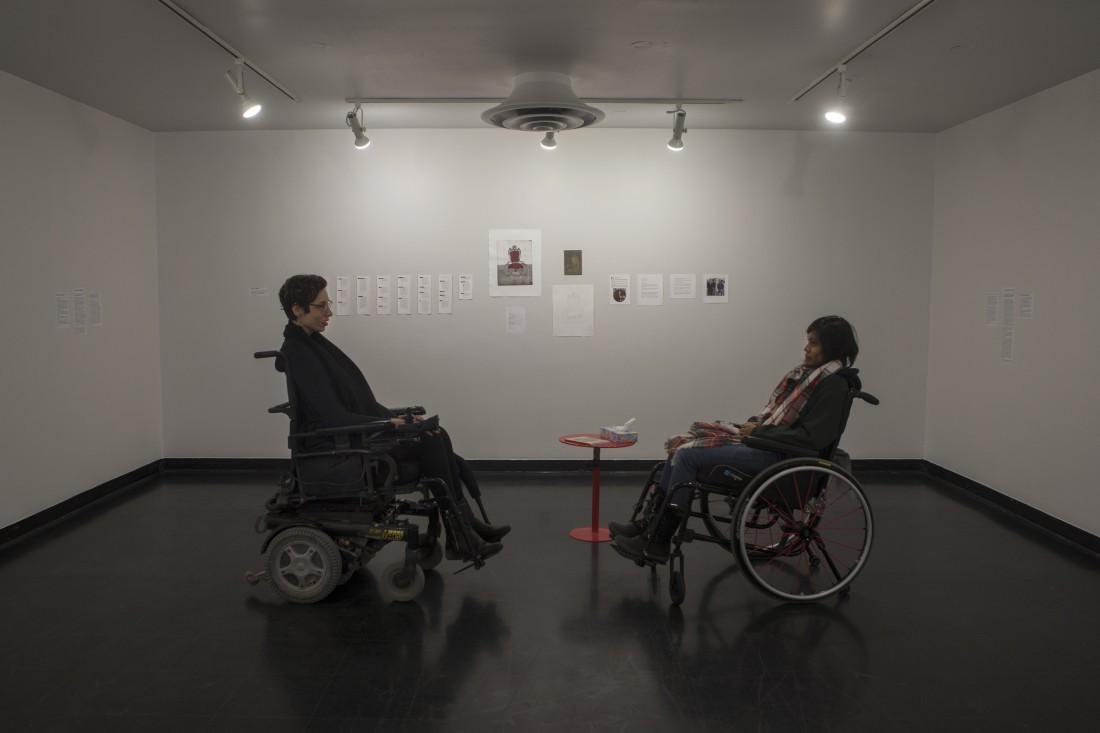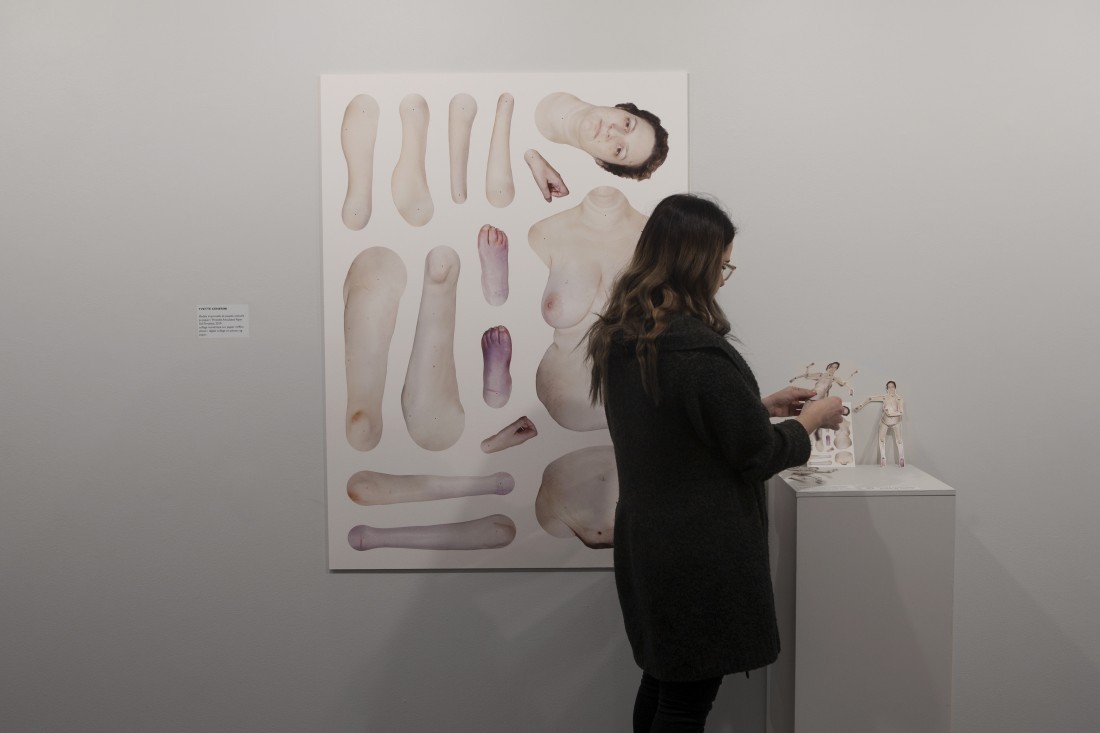“Yearning for Comfort, Not Cure”
I have spent the greater part of my life entangled in a search for a cure to my madness. From a young age I was made to believe that there was something wrong with the chemicals in my body, that I had a defect that ought to be fixed. For over a decade I led a desperate search for the right medications, the perfect cocktail of pills that would grant me some semblance of normalcy and gift me a cure.
In her curatorial essay for the exhibition “Yearning for Comfort, Not Cure,” Adele Ruhdorfer aptly writes that “cure continues to locate the problem of disability in the individual.” While medical treatment is a necessity for many, the goal of cure in medicalized discourse fails to recognize the disenfranchisement and oppression of disabled people and the impact of social stigma. In this exhibition, artists Yvette Cenerini, Lux Habrich, Bram Keast, melannie monoceros, Laurence Philomène and Jesse Turner each explore their own embodied experiences with disability, chronic illness and madness. Together, their work challenges the dominant discourse by drawing attention to how art and the creative process can facilitate comfort.

Jesse Turner, Take a Moment to Sit in My Chair, 2020, performance with installation of wheelchair, print and textual fragments. Photos: Karen Asher. Courtesy Gallery 1C03, University of Winnipeg.
Comfort, as Ruhdorfer argues, is care. In its broadest definition, “care” is not a new concept for the curatorial practice. The word “curator” comes from the Latin cura, most simply translated as “care” in English. A curator’s role, and the role of museums and galleries more generally, has been to care for material objects and the knowledges and histories they hold. While care often implies positive action, it has also been misappropriated and used as a tool for Western cultural institutions to justify their colonial plundering. Furthermore, the canon that determines what (and who) deserves care from these institutions is rooted in colonial, patriarchal, racist and ablest ideologies. By tying comfort to care, Ruhdorfer challenges and reinterprets care’s relationship to the curatorial process.
Care was not just present in the curatorial approach; it took shape differently in every work of art on display in “Yearning for Comfort, Not Cure.” To me, the notion of care was most stark in Cenerini’s work, Modèle imprimable de poupée articulée en papier/Printable Articulated Paper Doll Template. Working in digital media, Cenerini cut up her body parts from photographs and collaged them to create a paper doll template. Each body part featured marks that indicated where it should be (re) assembled with its adjoining parts. This process allowed Cenerini to see herself standing for the first time in decades. Postcard-sized templates of the paper doll were available for visitors to take home, offering a participatory element that leaves Cenerini’s body in the care of the viewer. The references to treatment and surgery are clear, as the participant is able to cut and assemble Cenerini’s body back together. However, this process, and what happens to the paper doll afterwards, forces the participant to confront their own role and responsibility in providing collective care.
Jesse Turner’s performance, Take a Moment to Sit in My Chair, also engages the participant to contemplate care. During several fourhour- long performances, Turner sat across from her old wheelchair and invited participants to take a seat. Non-wheelchair users may, at first, feel discomfort, unsure how to hold themselves, how to act and how to share space with Turner. However, over time, through mutual respect and understanding, both physical and emotional comfort are offered through the process of holding space. In their work, Puberty, Laurence Philomène also invites people into their space but does so through a series of 289 digital images that are presented as a chronological slide show. Through self-portraits that depict Philomène’s daily, mundane routine, these images document the experience of taking testosterone. Here, care is focused inwards, as people witness Philomène care for their body through experiences of medical transitioning and chronic illness.

Yvette Cenerini, Modéle imprimable de poupée articulée en papier/ Printable Articulated Paper Doll Template, 2019, digital collage on rag paper and postcard, 58 x 32 inches and 7 x 5 inches.
Using gouache and papier mâché, Bram Keast’s works, A Measurement of No Distance and Windless Chime, also explore themes of self-care. Keast draws on his experiences of sensory disability, resulting in works that are bold, colourful and abstracted. The often slow and laborious process of craft offers another method for self-care. Made between 2016 and 2019, Lux Habrich’s wall hanging, Mother’s Tears, reads almost as a diary. Combining traditional craft materials, such as fabric, natural dyes and beads, with silkscreen and photo-transfer appliqués of her family, Habrich reflects on diasporic communities, cross-generational trauma and mental illness.
Artist melannie monoceros also explores their embodied experiences through craft in their series, “Point of Origin.” Their quilt, Pain Map, offers a powerful interrogation of the medicalized need to locate pain in the body. Using red thread, monoceros stitched x-ray-like parts of their body onto the quilt. Near them, red thread is used once again, this time stitched in the form of questions: Where does it hurt? Where did it start? When? Here? How? Similar questions appear on the quilt in faint pencil, perhaps a testament to their enduring mark. In “Ancestors,” a series of mixed media woven tapestries and an accompanying poem, monoceros, a Black-Taino/Arawak person, draws on their roots to explore the experiences of influential Black poets, writers and artists and their shared histories. In doing so, monoceros questions the possibility of locating pain’s point of origin.
“Yearning for Comfort, Not Cure” reframes disability through its powerful centring of care and the lived experiences of disabled, chronically ill and mad people. By subverting the medicalized obsession with cure, both Ruhdorfer and the artists have created a space of comfort, where one can share and be vulnerable. I never found that perfect cocktail of pills, but I am no longer searching for one.
“Yearning for Comfort, Not Cure” was exhibited at Gallery 1C03, Winnipeg, from January 9 to February 8, 2020.
Marieke Gruwel writes about art and architecture from Winnipeg.

